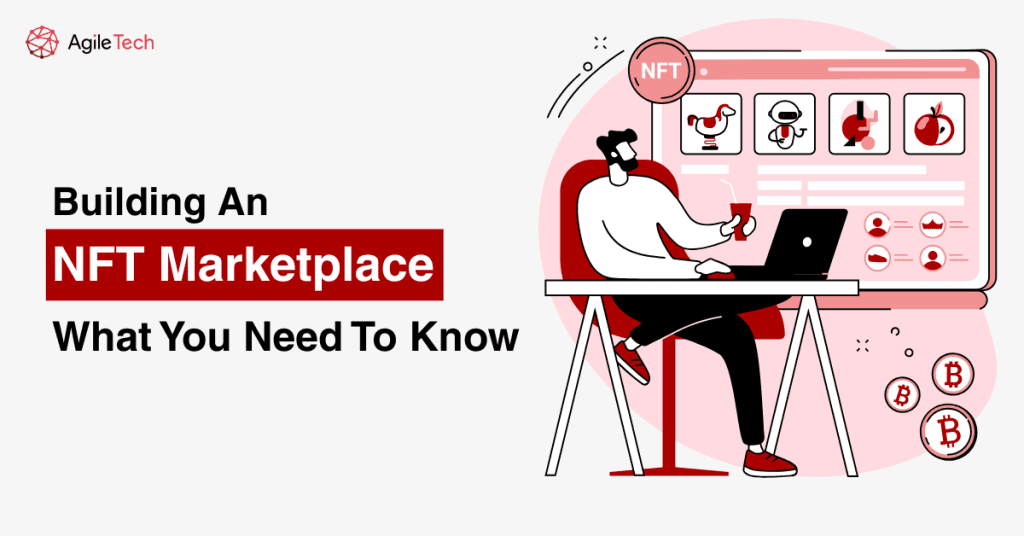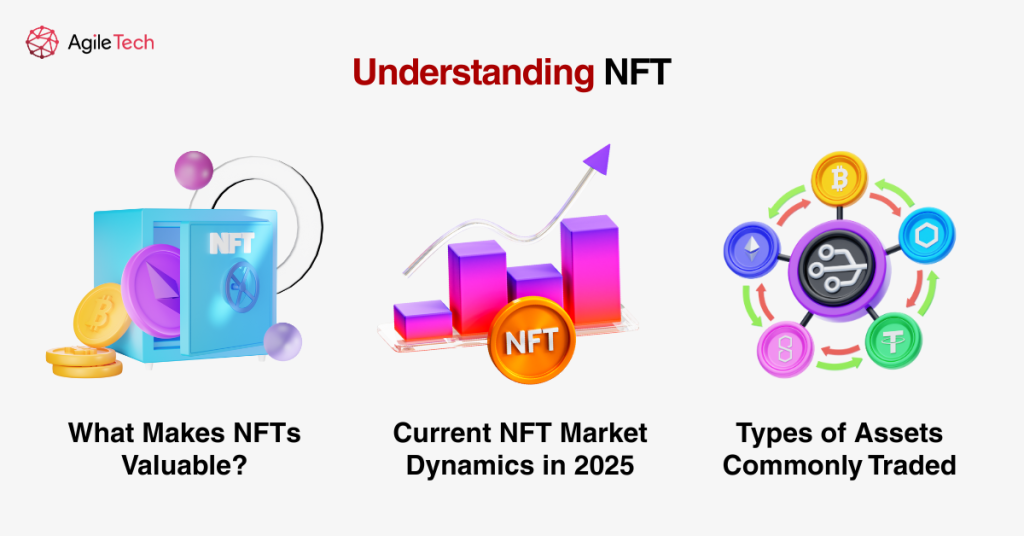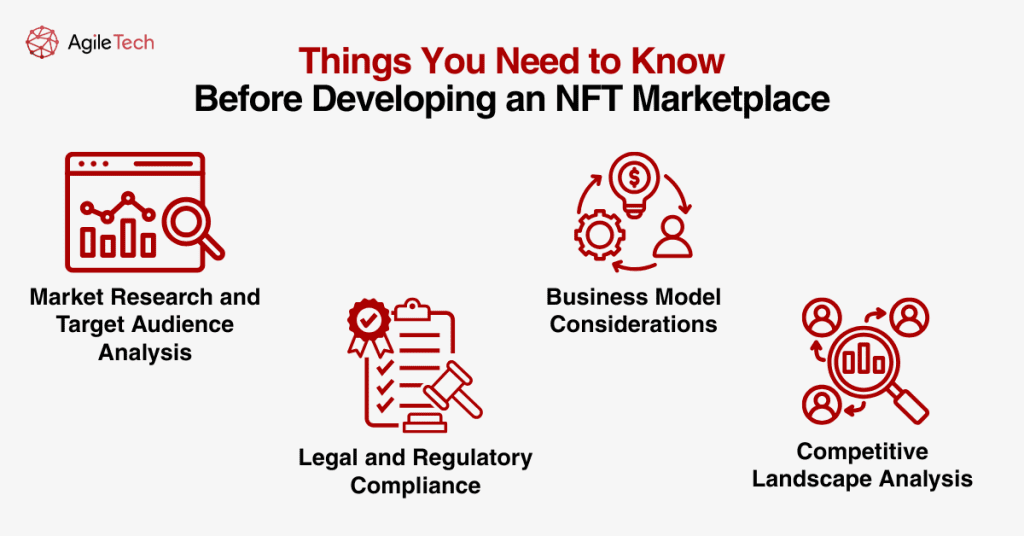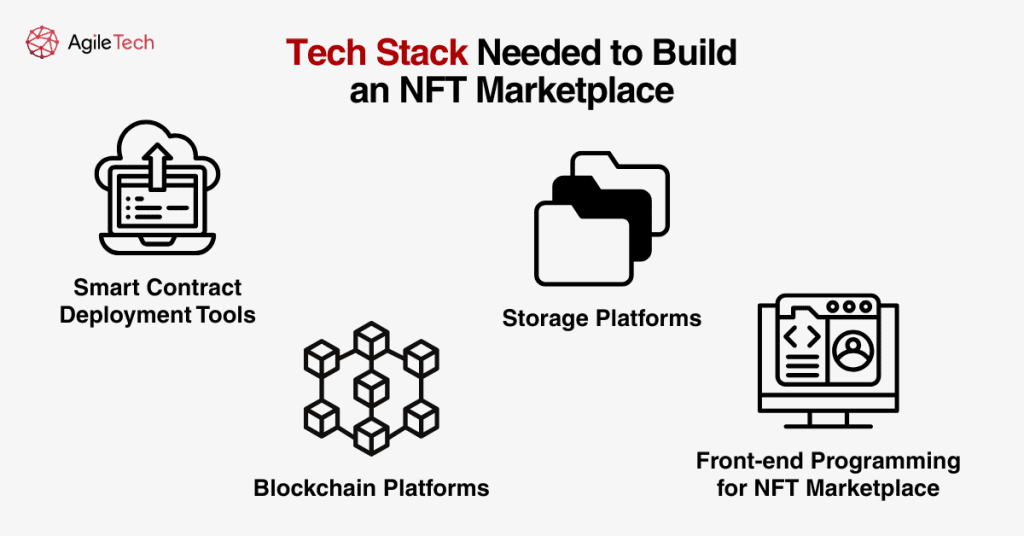Building An NFT Marketplace: What You Need To Know in 2025
The NFT marketplace landscape has evolved dramatically, transforming from a speculative novelty into a mature digital economy with real utility and value. As we navigate through 2025, the NFT market continues to demonstrate remarkable growth, with projections showing the sector will generate USD 608.6 million in revenue this year. The global NFT market, valued at USD 37.6 billion in 2024, is projected to reach an astounding USD 820.6 billion by 2035, representing a compound annual growth rate (CAGR) of 32.32%.

This explosive growth presents unprecedented opportunities for entrepreneurs and developers looking to build NFT marketplaces. However, success in this competitive landscape requires understanding the fundamental concepts, technical requirements, and strategic considerations that define modern NFT marketplace development. The maturation of blockchain technology, coupled with increasing mainstream adoption of digital assets, has created a fertile environment for innovative marketplace solutions that can capture significant market share.
1. Understanding NFT
Non-Fungible Tokens (NFTs) represent unique digital assets stored on blockchain networks, providing verifiable proof of ownership and authenticity for digital content. Unlike cryptocurrencies, which are fungible and interchangeable, each NFT contains distinct metadata that makes it irreplaceable and unique. This fundamental characteristic has revolutionized how we conceptualize digital ownership, creating entirely new economic models and value propositions.

1.1. What Makes NFTs Valuable?
The value proposition of NFTs extends far beyond simple digital ownership. They enable creators to establish scarcity, provenance, and transferable ownership rights for digital assets in ways that were previously impossible in the digital realm. This technology has fundamentally changed how we think about digital property, creating new economic models for artists, creators, and collectors while establishing trust and authenticity in digital transactions.
The intrinsic value of NFTs comes from their ability to solve the digital scarcity problem that has plagued digital content for decades. Before blockchain technology, digital files could be copied infinitely without degradation, making it impossible to create true scarcity or establish definitive ownership. NFTs solve this by creating a tamper-proof record of ownership and authenticity that exists independently of the underlying digital asset, providing collectors and investors with confidence in their digital property rights.
1.2. Current NFT Market Dynamics in 2025
The NFT ecosystem has matured significantly, moving away from purely speculative trading toward utility-driven applications that provide real value to users. This evolution represents a fundamental shift in how the market operates, with sustained growth driven by practical applications rather than hype-driven speculation.
The gaming NFT market alone was valued at USD 4.8 billion in 2024 and is estimated to grow at a 24.8% CAGR through 2034, driven by artificial intelligence and metaverse technologies integration. This growth reflects the increasing sophistication of NFT applications in gaming environments, where players can truly own their in-game assets and transfer them between different gaming platforms and experiences.
Modern NFTs increasingly offer practical benefits beyond collectible value, including access rights to exclusive communities, membership privileges in digital organizations, and functional applications in virtual environments and metaverse platforms. This utility-focused approach has created more sustainable demand patterns compared to the speculative bubbles that characterized earlier market phases.
Cross-chain compatibility has become essential for marketplace success, with leading platforms supporting multiple blockchain networks, including Ethereum, Solana, Polygon, and Binance Smart Chain simultaneously. This multi-chain approach allows users to choose the blockchain that best suits their needs in terms of transaction costs, speed, and ecosystem preferences while maximizing the potential market reach for marketplace operators.
The average revenue per user in the NFT sector is estimated at approximately $52.3 in 2025, indicating healthy monetization potential for marketplace operators. This figure represents a maturation of the market where sustainable business models have emerged, moving beyond the unsustainable high-value speculation that characterized the early NFT boom periods.
1.3. Types of Assets Commonly Traded
Contemporary NFT marketplaces facilitate trading across an increasingly diverse range of asset categories, reflecting the broadening applications of NFT technology across different industries and use cases. Digital art and collectibles remain the traditional strength of the NFT market, encompassing everything from algorithmically generated art pieces to hand-crafted digital masterpieces created by established and emerging artists.
Gaming assets represent one of the fastest-growing segments, including in-game items, character skins, virtual weapons, and digital real estate that can be used across multiple gaming platforms. The interoperability of these assets creates additional value for gamers who can invest in digital items that retain value and utility across different gaming experiences.
Music and audio NFTs have emerged as powerful tools for artists to build direct relationships with their fans while retaining greater control over their creative output and revenue streams. These assets often include exclusive content, early access to concerts, and direct communication channels between artists and their most dedicated supporters.
Virtual real estate has become a significant category as metaverse platforms continue to develop and attract users. Land parcels and properties in virtual worlds can generate ongoing revenue through development, leasing, and hosting virtual events, creating investment opportunities that mirror traditional real estate markets.
Utility tokens represent NFTs that provide access to services, communities, or exclusive experiences, often functioning as membership cards for premium digital services or exclusive communities. Domain names and digital identity assets have also gained traction as the importance of digital identity and branding in virtual spaces continues to grow.
2. Things You Need to Know Before Developing an NFT Marketplace

2.1. Market Research and Target Audience Analysis
Understanding your target market is absolutely crucial for NFT marketplace success, as the current landscape shows distinct user segments with varying needs, preferences, and behaviors. Collectors and investors represent one of the most valuable segments, typically seeking high-value, authentic pieces with strong provenance tracking and detailed historical data about previous ownership and transaction history.
Creators and artists form another crucial segment, requiring user-friendly minting tools that don’t require extensive technical knowledge, reasonable fee structures that don’t eat into their profits, and effective discovery mechanisms that help their work reach the right audiences. These users often prioritize platforms that offer robust creator support, including marketing assistance, community building tools, and educational resources.
Gamers represent a rapidly growing segment demanding seamless integration with gaming platforms and cross-game asset utility that allows them to use their NFTs across multiple gaming experiences. This segment values fast transaction speeds, low fees, and technical features that enhance their gaming experience rather than creating friction.
Enterprise users are increasingly entering the NFT space, needing robust security features, comprehensive compliance capabilities, and bulk transaction functionality that can handle large-scale operations. These users often require custom solutions, advanced analytics, and dedicated support teams to manage their NFT operations effectively.
2.2. Business Model Considerations
Successful NFT marketplaces in 2025 employ multiple revenue streams to create sustainable and diversified income sources. Transaction fees typically range from 2.5% to 5% of the sale price, though competitive pressure has kept fees at the lower end of this range as platforms compete for market share. The key is finding the right balance between profitability and competitiveness that attracts users while generating sufficient revenue to support platform operations and growth.
Listing fees represent another potential revenue stream, though this model has become less common as platforms recognize that charging creators upfront can discourage participation and limit the diversity of content available on the platform. Instead, many platforms have moved toward success-based fee structures that align platform incentives with creator success.
Premium services have emerged as a significant revenue opportunity, including advanced analytics tools for collectors and investors, promoted listing services that help creators increase visibility, and enhanced creator tools that provide additional functionality for professional artists and content creators. These value-added services can command higher margins while providing clear value to users willing to pay for premium features.
Cross-platform integration and revenue sharing arrangements with gaming platforms, metaverse environments, and other digital services create additional income opportunities while providing users with enhanced utility and interoperability for their NFT assets.
Read more: AgileBlockchain becomes a technical partner of DareNFT
2.3. Legal and Regulatory Compliance
The regulatory landscape for NFTs continues evolving rapidly, with governments and regulatory bodies worldwide developing frameworks to address the unique challenges posed by these digital assets. Intellectual property rights management has become increasingly complex, as platforms must ensure proper licensing and rights management for all listed content while protecting both creators and buyers from potential legal disputes.
Securities regulations represent a particular challenge, as determining when NFTs might be classified as securities varies significantly across different jurisdictions and depends on the specific characteristics and utility of individual tokens. Platforms must carefully structure their operations and token offerings to comply with relevant securities laws while providing clear guidance to users about potential regulatory implications.
Tax implications for NFT transactions have become increasingly important as tax authorities worldwide develop specific guidance for digital asset transactions. Successful platforms provide users with comprehensive transaction records and tax reporting tools that simplify compliance with local tax obligations.
Consumer protection measures, including adequate dispute resolution mechanisms and fraud prevention systems, are essential for maintaining user trust and potentially avoiding regulatory intervention. Platforms must balance the decentralized nature of blockchain technology with the need to provide users with reasonable protections against fraud, technical problems, and other issues.
2.4. Competitive Landscape Analysis
The 2025 NFT marketplace ecosystem includes a mix of established players and innovative emerging platforms, each carving out specific niches and competitive advantages. OpenSea remains the largest general-purpose NFT marketplace, leveraging its extensive feature set, large user base, and broad ecosystem support to maintain market leadership despite increasing competition.
Rarible has positioned itself as a community-governed platform with a strong focus on creator empowerment and decentralized governance, appealing to users who value community participation and platform democracy. SuperRare has built a successful business around curated, high-quality digital art, demonstrating the viability of premium, selective marketplace models.
Specialized marketplaces focusing on specific verticals like gaming, music, sports memorabilia, or virtual real estate have found success by providing tailored features and user experiences that better serve specific communities and use cases. These niche platforms often achieve higher user engagement and loyalty by understanding and serving the specific needs of their target audiences.
Success in this competitive environment requires either identifying underserved niches with specific unmet needs or providing superior user experience, lower fees, better features, or other clear value propositions compared to existing platforms. The key is finding sustainable competitive advantages that can be maintained over time as the market continues to evolve.
3. Tech Stack Needed to Build an NFT Marketplace

3.1. Blockchain Platforms
The choice of blockchain platform significantly impacts every aspect of marketplace functionality, including transaction costs, user experience, scalability, and ecosystem compatibility. This decision represents one of the most critical technical choices in marketplace development, as it affects both current operations and future growth potential.
Ethereum remains the most established blockchain for NFT applications, offering the largest existing ecosystem with extensive tooling, community support, and established smart contract standards, including ERC-721 for unique tokens and ERC-1155 for multi-token implementations. The Ethereum network provides unparalleled security and decentralization, with a massive user base and high liquidity that can provide immediate market access for new marketplaces. However, Ethereum’s success has led to network congestion issues that can result in high transaction fees during peak usage periods, potentially limiting accessibility for smaller transactions and casual users.
Polygon has emerged as a leading Layer-2 solution for Ethereum, offering the full compatibility of Ethereum’s ecosystem while providing significantly faster transaction speeds and lower costs. Polygon’s proof-of-stake consensus mechanism addresses environmental sustainability concerns while maintaining security and decentralization. The platform’s growing ecosystem and strong developer support make it an attractive option for marketplaces prioritizing user experience and accessibility while maintaining Ethereum compatibility.
Solana represents a high-performance alternative with impressive technical specifications, capable of handling over 50,000 transactions per second with typical transaction fees under $0.01. The platform’s fast block times enable near-instant transaction confirmation, creating a user experience that more closely resembles traditional web applications. Solana’s growing NFT ecosystem includes unique innovations like compressed NFTs that further reduce costs and environmental impact, though the platform’s newer ecosystem means fewer established tools and standards compared to Ethereum.
Binance Smart Chain offers another viable option, particularly for marketplaces targeting cost-conscious users and emerging markets. BSC’s low transaction fees, fast confirmation times, and large user base from Binance exchange integration provide immediate access to a substantial user community. The platform’s EVM compatibility enables easy porting of Ethereum-based applications and smart contracts, reducing development complexity for teams familiar with Ethereum development.
Many successful modern marketplaces have adopted multi-chain strategies that support multiple blockchain networks simultaneously, allowing users to choose based on their preferences for cost, speed, security, and ecosystem participation. This approach maximizes potential market reach and provides users with flexibility, though it significantly increases development complexity and ongoing maintenance requirements.
Read more: Your Ultimate Guide to NFT Marketplace Development
3.2. Storage Platforms
NFT metadata and asset storage require careful consideration of multiple factors, including decentralization principles, long-term cost implications, performance requirements, and data permanence guarantees. The storage solution directly impacts user experience, platform credibility, and the long-term viability of NFT assets.
IPFS (InterPlanetary File System) has become the standard for decentralized NFT storage, offering content-addressed storage that prevents tampering and ensures content permanence as long as nodes continue to host the data. IPFS provides cost-effective long-term storage solutions while maintaining decentralization principles that align with blockchain philosophy. The system’s widespread adoption across the NFT ecosystem ensures compatibility with wallets, browsers, and other infrastructure components. Implementation typically involves storing NFT metadata and media files on IPFS while recording only hash references on the blockchain, balancing decentralization with cost efficiency.
Arweave provides an alternative approach with its permanent storage model that requires only a one-time payment for theoretically permanent data storage. The platform’s economic model incentivizes long-term data preservation through a sustainable funding mechanism that pays storage providers over time. Arweave’s integration with major NFT platforms and strong data permanence guarantees make it particularly attractive for high-value NFTs where permanent storage is crucial for maintaining long-term value.
Traditional centralized storage solutions like AWS S3 and Google Cloud Platform offer superior performance, availability, and cost predictability, making them attractive for performance-critical applications and platforms with tight budget constraints. However, these solutions create centralization risks that potentially contradict blockchain principles and could result in asset loss if the centralized provider experiences problems or discontinues service. Many platforms use hybrid approaches that combine centralized storage for performance-critical applications with decentralized backup storage for long-term preservation.
3.3. Smart Contract Deployment Tools
Modern smart contract development requires sophisticated tooling that can handle the complexity of NFT marketplace operations while ensuring security, efficiency, and maintainability. The choice of development framework and deployment tools significantly impacts development speed, code quality, and long-term maintenance requirements.
Hardhat has emerged as the leading comprehensive Ethereum development environment, providing built-in testing frameworks, debugging tools, and deployment scripts that streamline the entire development lifecycle. The platform’s extensive plugin ecosystem enables integration with additional tools and services, while strong TypeScript support improves code quality and developer productivity. Hardhat’s local blockchain simulation capabilities allow thorough testing before mainnet deployment, reducing the risk of costly errors in production environments.
The Truffle Suite represents a mature alternative with extensive documentation and a large community of developers familiar with its patterns and practices. Truffle’s integrated testing and migration tools provide structured approaches to contract deployment and management, while Ganache offers sophisticated local blockchain testing environments that can simulate various network conditions and scenarios.
Smart contract standards have evolved to provide tested, secure foundations for NFT marketplace development. ERC-721 remains the standard for unique, non-fungible tokens, with each token containing a unique identifier and associated metadata. This standard provides broad compatibility across wallets and marketplaces but can result in higher gas costs for batch operations involving multiple tokens.
ERC-1155 offers a more efficient multi-token standard that supports both fungible and non-fungible tokens within a single contract, enabling more efficient batch operations that significantly reduce gas costs. This standard is particularly valuable for gaming applications and other use cases that involve multiple related asset types, though it requires more complex implementation and may have less universal support across existing infrastructure.
OpenZeppelin Contracts provides audited, secure smart contract libraries that implement common patterns and standards, reducing development time while ensuring security best practices. These pre-built implementations undergo regular security audits and community review, providing confidence in their reliability and security. The libraries receive regular updates that address newly discovered vulnerabilities and implement improvements based on community feedback and evolving best practices.
3.4. Front-end Programming for NFT Marketplace
The front-end development stack for NFT marketplaces must balance user experience, performance, and blockchain integration complexity while providing intuitive interfaces that make blockchain technology accessible to mainstream users. The choice of front-end technologies significantly impacts development speed, user experience, and long-term maintenance requirements.
React.js and Next.js have become the dominant choices for NFT marketplace development, offering component-based architecture that enables modular, maintainable development while providing excellent performance through server-side rendering and static site generation. Next.js particularly excels at SEO optimization, which is crucial for marketplace discoverability, while the extensive ecosystem of React-based blockchain libraries and components accelerates development of blockchain-specific functionality.
Vue.js and Nuxt.js provide alternative frameworks with gentler learning curves and excellent performance characteristics, though with smaller ecosystems of blockchain-specific tooling. These frameworks excel at creating performant applications with smaller bundle sizes, which can improve user experience particularly for users with limited bandwidth or older devices.
Blockchain integration requires specialized libraries that handle the complexity of connecting web applications to blockchain networks. Web3.js provides comprehensive functionality for Ethereum blockchain interaction with mature documentation and extensive community support, though its large bundle size and complex API can impact performance and developer experience. Ethers.js offers a modern, lightweight alternative with cleaner API design, better TypeScript support, and improved security through safer default behaviors.
Wagmi has emerged as a powerful solution for React applications, providing blockchain interaction through familiar React hooks patterns that integrate seamlessly with React state management and component lifecycles. The library’s TypeScript-first design provides an excellent developer experience while its built-in wallet connection and state management capabilities reduce development complexity.
Wallet integration represents a critical component of marketplace functionality, with WalletConnect providing protocol-level support for connecting decentralized applications to over 200 different wallet applications through QR codes and deep linking. MetaMask integration remains essential for Ethereum-based marketplaces, as it represents the most popular browser-based wallet with comprehensive developer documentation and extensive user adoption.
User interface development benefits from established component libraries like Material-UI and Ant Design, which provide pre-built components that accelerate development while ensuring consistent design language and accessibility features. These libraries offer customizable themes that enable brand alignment while maintaining usability best practices. Alternatively, Tailwind CSS has gained popularity for its utility-first approach that enables rapid custom design development with excellent performance characteristics and minimal CSS bundle sizes.
Advanced marketplace functionality requires sophisticated state management solutions, with Redux Toolkit providing comprehensive application state management for complex applications, while Zustand offers simpler alternatives for applications with more straightforward state requirements. React Query has become essential for managing server state and caching, providing optimistic updates and background synchronization that improve user experience for blockchain applications where transaction confirmation can take significant time.
Performance optimization becomes crucial for marketplaces handling large numbers of NFTs and high-resolution media assets. Image optimization, lazy loading, and CDN integration help ensure fast loading times even for users with limited bandwidth, while advanced search and discovery features using technologies like Elasticsearch enable users to efficiently navigate large NFT collections with sophisticated filtering and sorting capabilities.
Read more: How to Build NFTs: A Step-by-Step Guide for Beginners
4. The Bottom Line
Building a successful NFT marketplace in 2025 requires balancing technical excellence with deep market understanding and exceptional user experience design. The sector’s projected growth to USD 820.6 billion by 2035 represents enormous opportunity, but success demands careful planning and flawless execution across multiple dimensions including technology, business strategy, user experience, and regulatory compliance.
The technical foundation must be robust and scalable, with careful consideration of blockchain platform choices that balance cost, performance, and ecosystem compatibility. Smart contract implementation requires thorough security auditing and testing to prevent costly vulnerabilities, while storage solutions must balance decentralization principles with performance and cost requirements. The front-end must provide intuitive user experiences that make blockchain technology accessible to mainstream users while providing advanced functionality for sophisticated traders and creators.
User experience design has become the primary differentiator among technically competent platforms, with successful marketplaces prioritizing intuitive interfaces, fast loading times, and seamless wallet integration that reduces friction for both creators and collectors. The onboarding process must be streamlined to accommodate users unfamiliar with blockchain technology while providing advanced features for experienced users.
Market positioning requires identifying underserved niches or providing superior value propositions compared to existing platforms through lower fees, better features, superior customer service, or unique functionality that addresses specific user needs. Community building has proven essential for long-term success, with thriving platforms fostering active creator and collector communities through incentive programs, social features, educational content, and excellent customer support that builds loyalty and encourages organic growth.
Regulatory compliance cannot be treated as an afterthought, as the evolving regulatory landscape requires proactive compliance measures implemented from platform launch. This includes intellectual property protection, securities law compliance, tax reporting capabilities, and consumer protection measures that build user trust while avoiding potential regulatory problems.
The investment and timeline considerations for marketplace development typically require six to twelve months for a minimum viable product and twelve to eighteen months for a full-featured platform with advanced functionality. Initial investment requirements range from $100,000 to $500,000 depending on feature complexity, team size, and geographic location, with ongoing costs including blockchain transaction fees, storage expenses, infrastructure maintenance, and continuous development.
Future-proofing successful platforms requires embracing interoperability through multi-chain support and cross-chain functionality that maximizes user choice and market reach. Integration of emerging technologies including artificial intelligence for content discovery and recommendation, augmented and virtual reality for immersive experiences, and advanced analytics for market insights, will become increasingly important competitive differentiators.
The focus must shift toward utility-driven NFTs that provide real value beyond simple collectible speculation, including functional applications in gaming, virtual worlds, and digital services that create sustainable demand patterns. Environmental sustainability considerations require careful blockchain selection and potentially supporting carbon offset programs that address growing environmental consciousness among users and creators.
The NFT marketplace opportunity in 2025 remains substantial for teams that combine solid technical foundations with innovative user experiences, strong community building capabilities, and a deep understanding of evolving market dynamics. Success requires comprehensive planning, significant technical expertise, substantial financial resources, and unwavering commitment to user experience and community building. Those who execute successfully across all these dimensions will be best positioned to capture significant value in this rapidly growing and evolving market.
Conclusion
The NFT marketplace sector in 2025 presents immense opportunities—driven by real-world utility, evolving user needs, and rapid technological advancement. However, building a successful platform requires more than just deploying smart contracts. It demands a well-chosen tech stack, deep audience understanding, regulatory readiness, and a seamless user experience across chains and devices.
As NFTs shift from speculative assets to integrated digital tools, marketplaces must evolve into ecosystems that empower creators, engage communities, and unlock long-term value. Those who execute with both vision and precision will be the ones to define the next chapter of the NFT economy.
